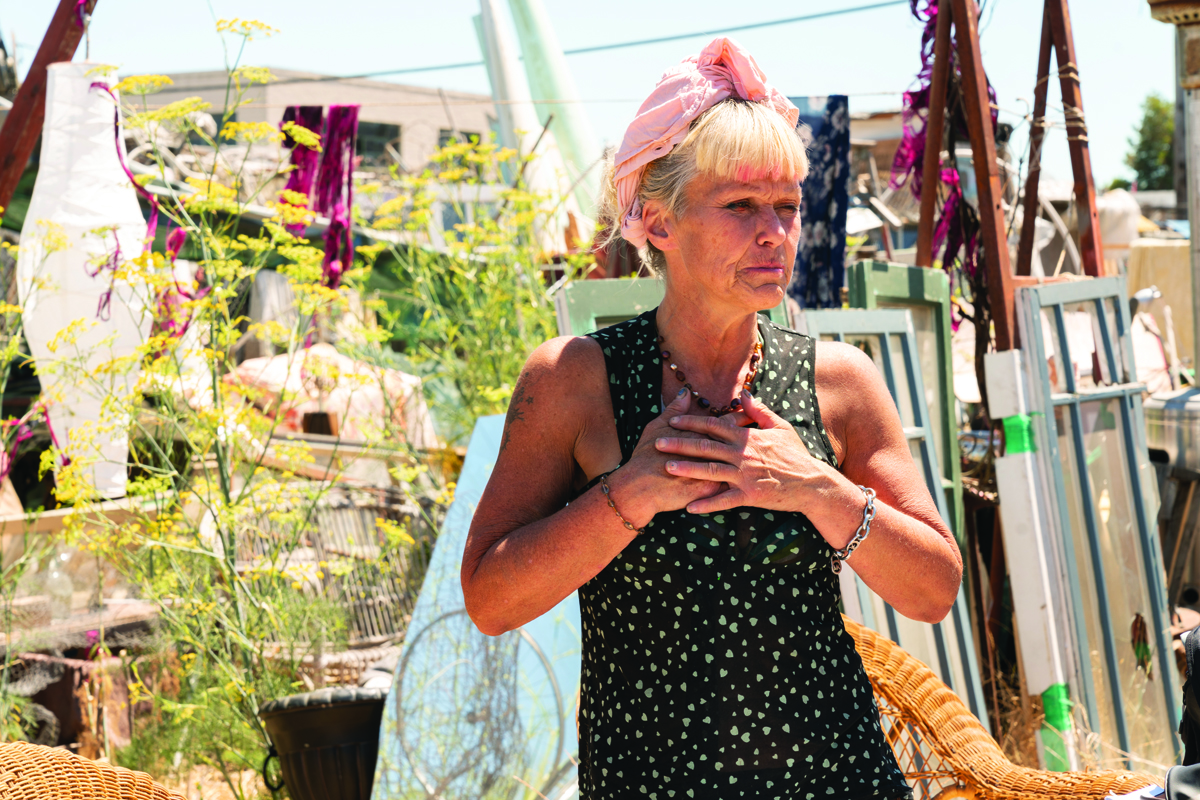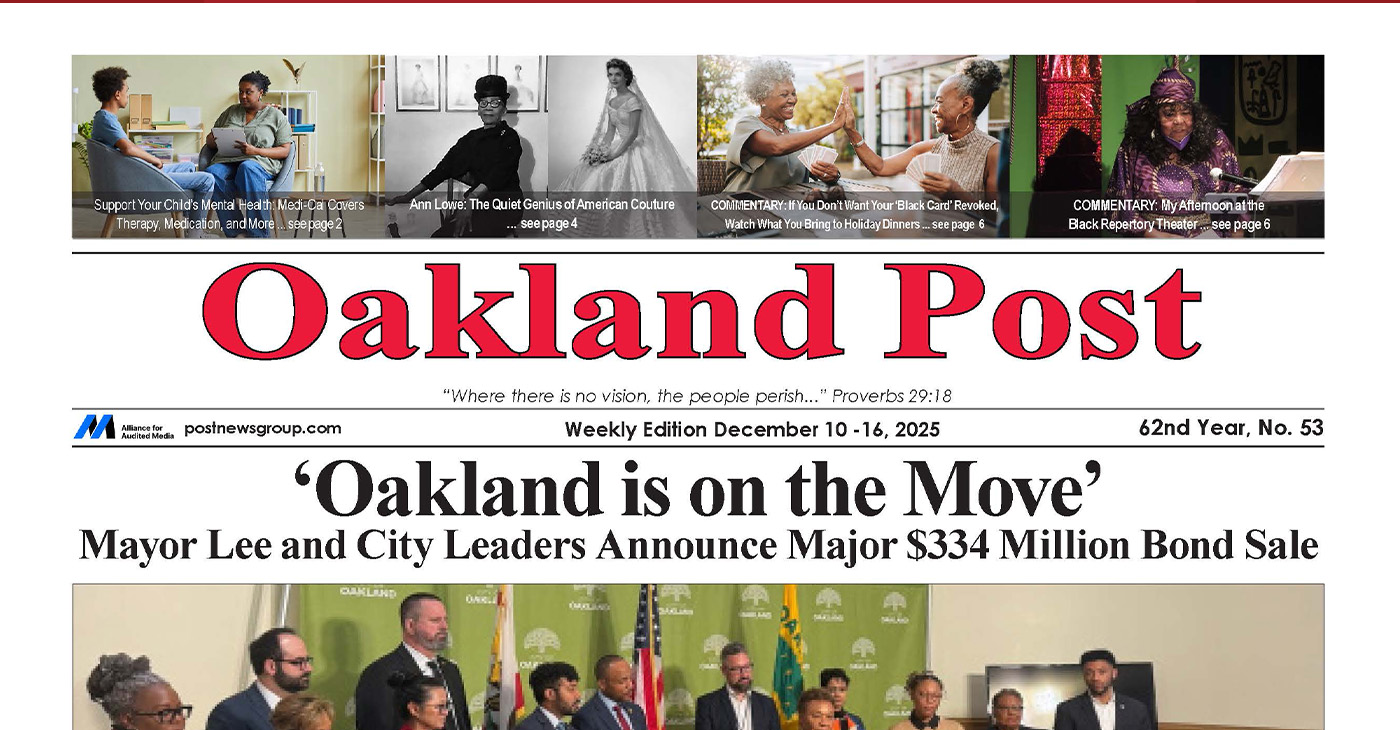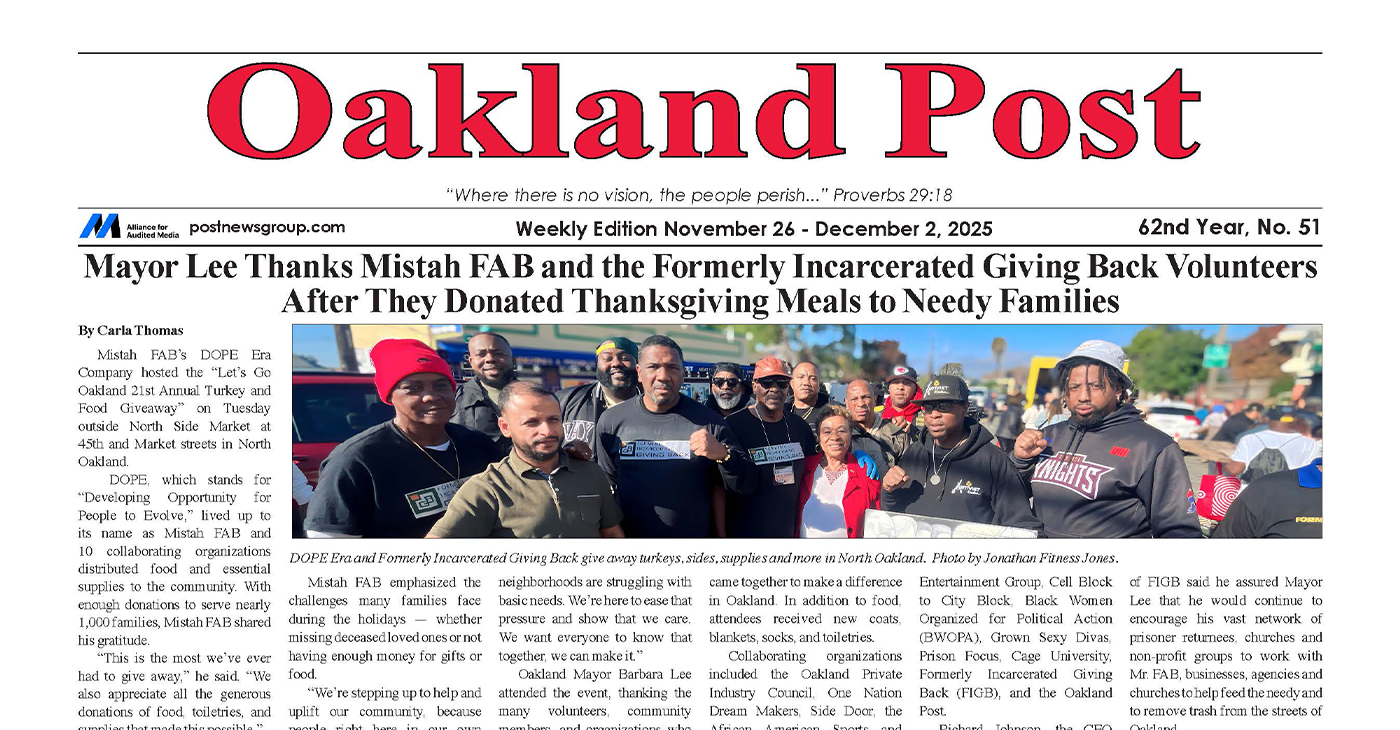Homeless
Homelessness, From Burning Man to Wood Street

A self-described performance artist, Mavin Carter- Griffin said she can perform art anywhere. Her “curb urban loft” at the Woodside homeless encampment in West Oakland is decorated with a motorcycle on top of a trailer. The three-room home is a roomy, carefully assembled wood structure that includes a living room space, bedroom, and kitchenette. Light beams through cracks from the ceiling with illusive purpose as veils of colorful fabrics blow in the wind.
Fifty-four-year-old Carter-Griffin said she has been homeless for 10 years, six of of which were spent living in West Oakland. A fifth generation San Franciscan, she has lived in the Bay Area almost all of her life.
Carter-Griffin said she once had a business making sculptures, selling them at retailers like Macy’s. Before she became homeless, Carter-Griffin also had a home in Crockette, but she lost it when her grandmother’s property was partitioned.
“I don’t have any family left,” Carter-Griffin said. “I had my mom, my aunt, my uncle, and they were the people that took my house from me.”
Carter-Griffin said there is a lot of shame and blame involved in being homeless. That is one of the reasons she prefers calling the Woodside encampment a “curbside community.” She said being homeless is stigmatizing in such a way it can leave a person socially blackballed, making it harder to get a job or go anywhere in public if there is no possibility for simple necessities like grooming products, clothing and access to showers.
Carter-Griffin equates being homeless to being a settler, “from back in the days when you came over in wagons, only these days people use RVs.”
Self-preservation is key, she explained, and it can often be an exhausting experience.
“Google homelessness, you’re going to see the typical sad images of people sleeping on the curb,” Carter-Griffin said. She wants that narrative to change. There are people who can sleep on the sidewalk and not bathe for long periods of time, but Carter-Griffin describes that type of living so hardcore that one would have to divorce their mind, spirit, and body from everything.
Carter-Griffin admits there are some who are problematic at camps, people who dump vehicles, steal and sometimes become violent. She is fine with the city’s Tuffshed programs and efforts, but she sees potential in the people of her curbside community, most of which are peaceful and have unique skills. That is why she wants to start what she calls a “random citizen pilot.”
“There are people who would act differently if they were trained,” she said. “The people who stay on-site would be the ones responsible to create a Burning Man campus for living affordably.”
Integrating homeless populations as part of society instead of treating them like outsiders that are a social illness is essential, according to Carter-Griffin. She believes in building a cooperative society.
“The only way we are going to be seen as human beings is to be treated as human beings,” she said. “Not everyone can fit into these molds they’re trying to fit us into.”
Under the Burner “playa” name Alchemy, Carter-Griffin went to Burning Man almost every year since 2000. Burning Man is a world-famous cultural event held annually in a remote desert at Black Rock City, NV., Years of attending the festival and being homeless has inspired Carter-Griffin to think outside the usual homeless solutions that tend to focus on moving nameless, faceless bodies off streets in systematic motion to quickly appease the aesthetics of a neighborhood. She wants the now often wealthy attendees of Burning Man to go back to their root principles and use those principles to improve society as a whole.
The 10 principles of Burning Man started as a guideline in 2004 by Co-Founder Larry Harvey. The principles are radical inclusion, gifting, decommodification, self-reliance, self-expression, communal effort, civic responsibility, leaving no trace, participation, and immediacy, which is to recognize the barriers that stand between a recognized inner self.
“If 85,000 people can leave no trace in a temporary city every year based on Burning Man principles, the same can be applied to curbside urban encampments,” Carter-Griffin said.
Calling it a radical housing solution, she said unhoused residents can use skill sets like gardening, carpentry, and artistry to create economic industrial potential, creating jobs while designing a culture of co-habitation with the environment. She said Burning Man runs several non-profits, and she would like to pitch the concept of a non-profit encampment co-op that works in the same way Burning Man does every year. She would call the organization “The Department of Curban Affairs,” and the co-op style “curb urbanization.”
Carter-Griffin said using the principles of Burning Man and rethinking the urban landscape is about rethinking the urban landscape to include all people, including the few people who like to live “inside out,” meaning, the few who do not want to live indoors.
“People living outdoors is nothing new, we’ve just become detached from that way of thinking,” Carter-Griffin said.
Through grants and camp residents starting their own businesses, Carter-Griffin wants a sustainable community that builds, creates, gifts and applies community self-reliance. She wants unused land to be turned into permaculture gardens, a sustainable and low-maintenance way to cultivate land. She also wants an on-site radio station. Podcasting can work as well but many unhoused people have free government provided “Obama phones” that do not provide much data for streaming podcasts. Other skill sets Carter- Griffin would like to foster at camps are writing, journalism, and talk shows.
Currently, gathering solutions for issues like obtaining water, bathrooms, and toiletries are on the top of Carter-Griffin’s list of asks when it comes to the needs of her curbside community.
Envisioning tiny homes that look like the creative art style seen at Burning Man, Carter- Griffin wants Oakland to be seen as an example to show the world how Curb Urbanization can work. Her own loft was created using wood and materials discarded in the process of home renovations in West Oakland. Carter-Griffin said she wants to re-using the materials left behind from gentrification, she has found family portraits that she plans to hang up in memory of those who have been pushed out of their neighborhoods.
When it comes to the one dream Carter-Griffin wants the most, she said, “I just want my house back,” one with an extra room for her daughter to live with her. She copes with the pain of missing her daughter by focusing on improving what she sees around her, turning trash into gold, she said, is what an Alchemist is meant to do.
Carter-Griffin wants to find a way to go to Burning Man this year to try and get Burners interested in her ideas, but she said she is too poor to obtain free tickets. There are tickets for low-income attendees, but they require showing W-2 forms and Carter-Griffin has not had a job or a bank account, making her unable to apply.
She currently makes no money. Receiving food stamps helps a lot, but those benefits have recently been cut. Despite that, Carter-Griffin said as long as she has food, water, and her loft, she is fine and will continue squatting at Woodside so she can fight for something more than being shuffled into a Tuff Shed with a potential future of low-paying, dead-end work that cannot sustain affordable living in the Bay Area, CA.
Activism
Mayor Lee, City Leaders Announce $334 Million Bond Sale for Affordable Housing, Roads, Park Renovations, Libraries and Senior Centers
Saying “Oakland is on the move,” Mayor Barbara Lee announces results of Measure U bond sale, Dec. 9, at Oakland City Hall with city councilmembers and city staff among those present. Photo courtesy of the City of Oakland.

By Post Staff
The City of Oakland announced this week that it is successfully moving forward on the sale of $334 million of General Obligation bonds, a milestone that will provide the city with capital funding for city departments to deliver paved roads, restored public facilities, and investments in affordable housing.
“Oakland is on the move and building momentum with this bond sale,” said Oakland Mayor Barbara Lee. “We are reviving access to funding for paving our streets, restoring public facilities we all use and depend upon, and investing in affordable housing for our community, all while maintaining transparency and fiscal discipline.”
“These bonds represent our city’s continued commitment to sound financial management and responsible investment in Oakland’s future,” said Lee.
“Together, we are strengthening our foundation for generations to come,” she said. “I’m grateful to our partners in the City Council for their leadership and support, and to City Administrator Jestin Johnson for driving this process and ensuring we brought it home.”
According to the city, $285 million of the bonds will support new projects and $49 million of the bonds will refund existing bonds for debt service savings.
Oakland issued the Measure U bonds on Dec. 4 after two years of delays over concerns about the city’s financial outlook. They all sold in less than a week.
The new money bonds will pay for affordable housing, roadway safety and infrastructure improvements, and renovations to parks, libraries, senior centers, and other public facilities under the city’s Measure U Authorization.
Citywide paving and streetscape projects will create safer streets for Oaklanders. Additionally, critical facilities like the East Oakland Senior Center and San Antonio Park will receive much-needed renovations, according to the city.
Some of the projects:
- $50.5 million – Citywide Street Resurfacing
- $13 million – Complete Streets Capital Program
- $9.5 million – Curb Ramps Program
- $30 million – Acquisition & Preservation of Existing Affordable Housing
- $33 million – District 3: Mandela Transit-Oriented Development
- $28 million – District 6: Liberation Park Development
- $3 million – District 5: Brookdale Recreation Center Capital Project
- $1.5 million – District 1: Oakland Tool Lending Library (Temescal Branch Library)
- $10 million – District 3: Oakland Ice Center
“I recognize that many naysayers said we couldn’t do it,” said Johnson. “Well, you know what? We’re here now. And we’re going to be here next year and the year after. The fact is we’re getting our fiscal house in order. We said we were going to do it — and we’re doing it.”
Investors placed $638 million in orders for the $334 million of bonds offered by the City. There was broad investor demand with 26 separate investment firms placing orders. The oversubscription ultimately allowed the city to lower the final interest rates offered to investors and reduce the city’s borrowing cost.
“The oversubscription ultimately allowed the City to lower the final interest rates offered to investors and reduce the City’s borrowing cost,” said Sean Maher, the city’s communications director.
“The Oakland City Council worked closely with the administration to both advance the bond issuance process and ensure that the community had a clear understanding of the City’s timeline and approach,” said Councilmember at-Large Rowena Brown.
“In September, the City Council took unanimous action to authorize the Administration to move forward with the bond sale because these funds are essential to delivering the very improvements our communities have long asked for – safer streets, restored public facilities, and expanded affordable housing,” she said.
Continuing, Brown said, “I want to extend my sincere thanks to City Administrator Jestin Johnson, Finance Director Bradley Johnson, and Mayor Barbara Lee for their leadership, diligence, and steady guidance throughout the City’s bond sale efforts.
“Navigating complex market conditions while keeping Oakland’s long-term infrastructure needs front and center is no small task, and this moment reflects tremendous professionalism and persistence,” she said.
Moody’s gave the city an AA2 rating on the bonds, its third-highest rating, which it gives to high-quality investment-grade securities.
There was both a tax-exempt portion and a taxable portion for the bond offering, reflecting the various uses of the bond proceeds, according to a statement released by the city.
The $143.5 million of tax-exempt bonds have a 30-year final maturity and received an all-in borrowing cost of 3.99%. The $191 million of taxable bonds have a 24-year final maturity and received an all-in borrowing cost of 5.55%.
The $49 million in tax-exempt bonds that refinance existing obligations of the City resulted in $5.6 million of debt service savings for taxpayers through 2039, or $4.7 million on a present value basis.
Mayor Lee said that, based on her experience serving on the House Financial Services Committee of the U.S. Congress for more than 10 years, city staff has done an exemplary job.
“I have witnessed many cities go to the bond market throughout the years,” she said. “I can tell you with certainty that Oakland’s team is remarkable, and our residents should be proud of their reputation, their competence, and their deep knowledge of this very sophisticated market.”
Looking ahead to the final sale of the bonds, according to the city press statement, pricing marks the point at which the City and investors locked in the final dollar amounts, interest rates, and other key terms of the bond sale. This stage is commonly referred to as the sale date. At pricing, no funds are exchanged. The actual delivery of bonds and receipt of monies occurs at closing, which is scheduled within the next two weeks.
Capital projects receiving this funding will proceed on individual timelines based on their individual conditions and needs. At the time of closing, funding will be immediately available to those projects.
Activism
Oakland Post: Week of December 10 – 16, 2025
The printed Weekly Edition of the Oakland Post: Week of – December 10 – 16, 2025

To enlarge your view of this issue, use the slider, magnifying glass icon or full page icon in the lower right corner of the browser window.
Activism
Oakland Post: Week of November 26 – December 2, 2025
The printed Weekly Edition of the Oakland Post: Week of November 26 – December 2, 2025

To enlarge your view of this issue, use the slider, magnifying glass icon or full page icon in the lower right corner of the browser window.
-

 Activism4 weeks ago
Activism4 weeks agoOakland Post: Week of November 12 – 18, 2025
-

 Activism4 weeks ago
Activism4 weeks agoIN MEMORIAM: William ‘Bill’ Patterson, 94
-

 Activism4 weeks ago
Activism4 weeks agoHow Charles R. Drew University Navigated More Than $20 Million in Fed Cuts – Still Prioritizing Students and Community Health
-

 Bay Area4 weeks ago
Bay Area4 weeks agoNo Justice in the Justice System
-

 #NNPA BlackPress3 weeks ago
#NNPA BlackPress3 weeks agoBeyoncé and Jay-Z make rare public appearance with Lewis Hamilton at Las Vegas Grand Prix
-

 Activism3 weeks ago
Activism3 weeks agoOakland Post: Week of November 19 – 25, 2025
-

 #NNPA BlackPress3 weeks ago
#NNPA BlackPress3 weeks agoLewis Hamilton set to start LAST in Saturday Night’s Las Vegas Grand Prix
-

 #NNPA BlackPress2 weeks ago
#NNPA BlackPress2 weeks agoLIHEAP Funds Released After Weeks of Delay as States and the District Rush to Protect Households from the Cold








































